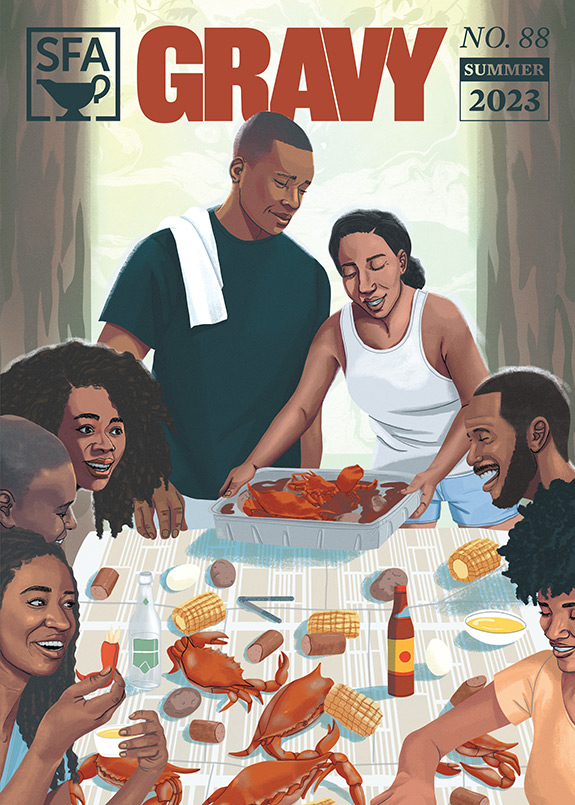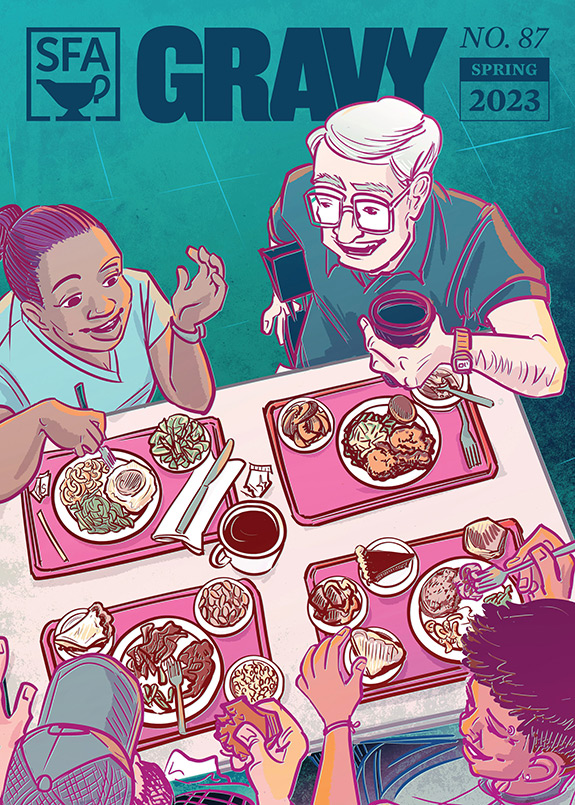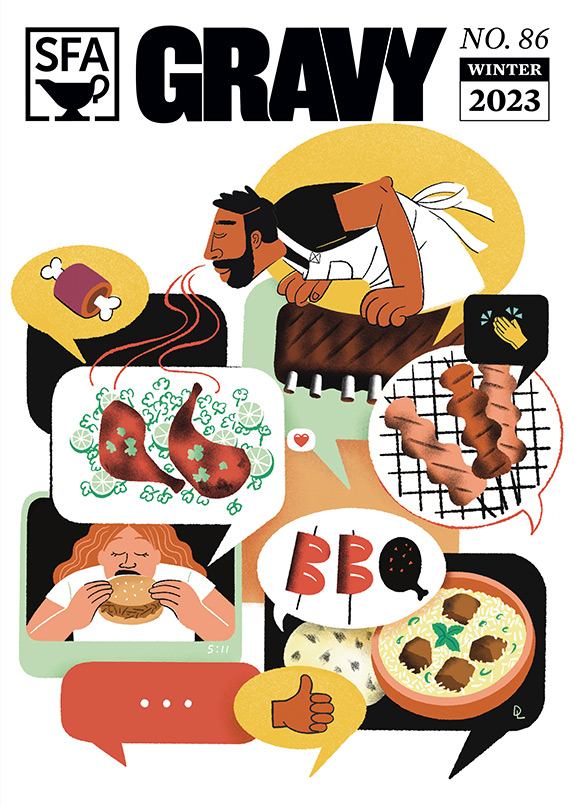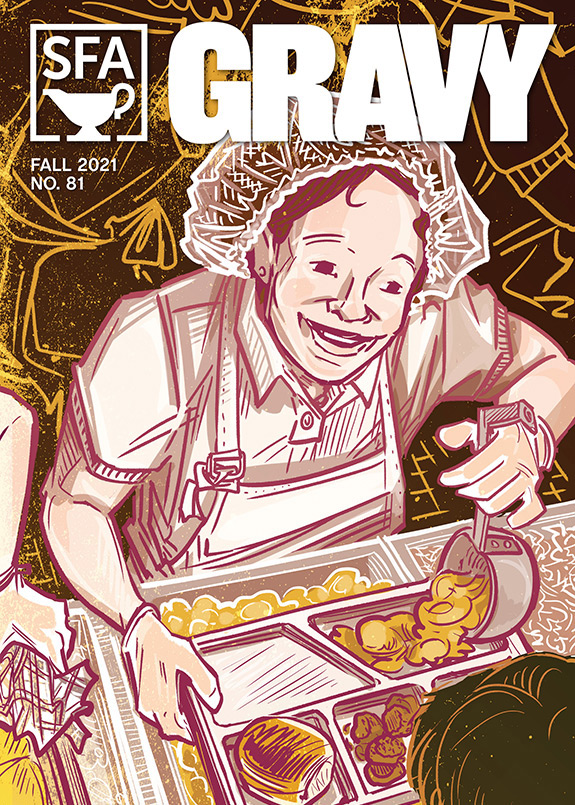Remembering Leah Chase The matriarch of Creole cuisine passed away Saturday.
Leah Chase, who passed late Saturday night, served as the first president of the Southern Foodways Alliance board of directors. More important, she served this region and nation as a moral leader. Her civil rights movement era activism, work ethic, and empathetic world view set standards that are lodestars. Here, longtime SFA member John Pope has the definitive obituary.
By John Pope, NOLA.com | The Times-Picayune
Leah Chase, New Orleans’ matriarch of Creole cuisine, who fed civil rights leaders, musicians and presidents in a career spanning seven decades, died Saturday (June 1) surrounded by family. She was 96.
Mrs. Chase, who possessed a beatific smile and a perpetually calm demeanor, presided over the kitchen at Dooky Chase’s Restaurant until well into her 10th decade, turning out specialties such as lima beans and shrimp over rice, shrimp Clemenceau and fried chicken that was judged the best in the city in a poll by NOLA.com | The Times-Picayune. Every Holy Thursday, hundreds showed up to enjoy gallons of her gumbo z’herbes, a dark, thick concoction that contains the last meat to be eaten before Good Friday.
In May 2016, Mrs. Chase received a Lifetime Achievement Award from the James Beard Foundation, which sponsors the country’s foremost food-related awards program for chefs, restaurateurs and writers. The foundation, which is named for a cookbook author and teacher who died in 1985, is, according to its website, designed to “celebrate, nurture and honor America’s diverse culinary heritage through programs that educate and inspire.”

Mrs. Chase fed most of the civil rights movement’s leaders, as well as African-American entertainers who couldn’t eat in any other New Orleans restaurant during the Jim Crow years. President George W. Bush ate there, as did U.S. Sen. Barack Obama during the 2008 presidential campaign, when Mrs. Chase stopped him from adding hot sauce to her gumbo.
Nothing seemed to slow her down. When she was hospitalized briefly in July 2015 to get a pacemaker, Mrs. Chase grumbled about the enforced idleness, saying, “I’ve got work to do.”
Her life was one of hard work, and of overcoming obstacles. Born into poverty, Mrs. Chase came of age when segregation was legal and interracial mixing was forbidden.
In August 2005, Hurricane Katrina-related floodwaters overwhelmed her home and her restaurant, which was also looted. She and her husband, Edgar “Dooky” Chase II, lived for more than a year in a FEMA trailer across from the Orleans Avenue eatery.

Restoring the restaurant took two years, but she never wavered in her determination to rebuild, said Kim Severson, an Atlanta-based correspondent for the New York Times who writes frequently about food.
“It’s very rare to find someone with her fortitude and that kind of unwavering optimism,” Severson said. “She said, ‘We’ll come back. You can’t keep us down. … We’ll come back because we have to come back.’ You could look at her and believe what she was saying.”
Severson said Mrs. Chase liked to cite the sankofa, an African symbol showing a bird reaching back as it flies forward. It has come to represent taking from the past and using it to build a better future.
“She said, ‘We have to look back but keep moving forward,’” Severson said. “That says a lot about her. She knew what it had taken for her to get she was, but she never stopped moving forward, which I think was the essential heart and soul of that woman.”
Although Mrs. Chase was best known as a chef, her reputation and interests extended beyond her Treme kitchen.
A longtime trustee of the New Orleans Museum of Art who said she liked beautiful things, Mrs. Chase was a patron and friend of artists. On the restaurant’s walls were paintings by renowned artists such as Jacob Lawrence and Elizabeth Catlett, both of whom were her friends, as well as Rise Delmar Ochsner’s portrait of her.
Mrs. Chase traveled to Washington to testify before Congress on behalf of the National Endowment for the Arts, telling a House subcommittee that “neighborhood kids, like me a long time ago, need to see something beautiful and breathtaking in order to aspire to higher things and to value living more.”
In such moments, “she called forth our better instincts,” said John T. Edge, director of the Southern Foodways Alliance, an organization that studies and celebrates Southern cuisine.
“She led by example and reminded us that there’s more than what’s in the bottom of the gumbo pot,” Edge said. “Her food is great, but people responded to her because of what’s in her heart and because of the life she’s lived. When they were in her presence, they were responding to that life well lived.”
Brian Lanker photographed her, along with other notable African-American women such as Oprah Winfrey, Leontyne Price, Rosa Parks and Toni Morrison, for “I Dream a World: Portraits of Black Woman Who Changed America,” a 1999 exhibit of 75 pictures at the Corcoran Gallery in Washington.
A portrait of Mrs. Chase chopping squash in her restaurant hangs in the National Portrait Gallery. In 2002, Hannibal Lokumbe composed “Gumbo à la Freedom: The Spices of Leah Chase” in her honor, using pots from her kitchen to augment the percussion section when the Louisiana Philharmonic Orchestra performed it. Her red chef’s jacket is on display in an exhibit devoted to the restaurant at the National Museum of African American History and Culture in Washington, D.C.
She also was the inspiration for Princess Tiana in the Disney animated feature “The Princess and the Frog.” Tiana, who wants to own a restaurant in the French Quarter, was the first African-American princess in a Disney movie.
Mrs. Chase received scores of other accolades, including The Times-Picayune Loving Cup, but she never felt she deserved any of the praise, said John Folse, the chef and restaurateur who helped restore Dooky Chase’s.
“She felt they were giving her more than she could give, and it was just the opposite,” Folse said. “What has always set Leah apart is how humble and respected she was of every person, never feeling that she deserved the greatness than she had earned.”
Leah Lange Chase, one of 14 children, was born in Madisonville on Jan. 6, 1923. Since her hometown had no schools for black children after the sixth grade, she moved to New Orleans to live with an aunt while she finished high school.
After graduation, she had a diverse career path that included managing two amateur boxers and managing a racehorse bid for a local bookie. Most importantly, she waited tables at a French Quarter restaurant, where she developed an appreciation of food.
In 1946, shortly after marrying Dooky Chase, she took over the kitchen at the restaurant his parents had started in 1941 as a sandwich stand. It evolved into a white-tablecloth establishment that was the only restaurant of that caliber where African-Americans could eat in a segregated city.
Her clientele included such notable black entertainers as Lena Horne, Count Basie and Sarah Vaughan. Ray Charles mentioned it in his song “Early in the Morning.” (“I went to Dooky Chase to get me something to eat.”)
In the 1950s, as the drive for civil rights was gathering momentum, the restaurant became the gathering place for local and national leaders of the movement, black and white, to eat and plot strategy, even though their presence in an upstairs room flouted the law against interracial gatherings, said Sybil Morial, who was active in the movement.
“I don’t think (the Chases) gave it a second thought,” she said. “They were breaking the law, but they thought it was important to do it. … It was extraordinary.”
The Rev. Martin Luther King Sr., known universally as “Daddy King,” was particularly fond of the spareribs, Mrs. Chase said, and the writer James Baldwin loved her gumbo.
“Everybody likes a bowl of gumbo,” Mrs. Chase said during the celebration of her 90th birthday. “I like to think we changed the course of America in this restaurant over a bowl of gumbo.”
In addition to welcoming the movement’s leaders, the restaurant’s doors were open to black and white people who were picketing Canal Street stores in an attempt to open up more jobs to African-Americans, Morial said.
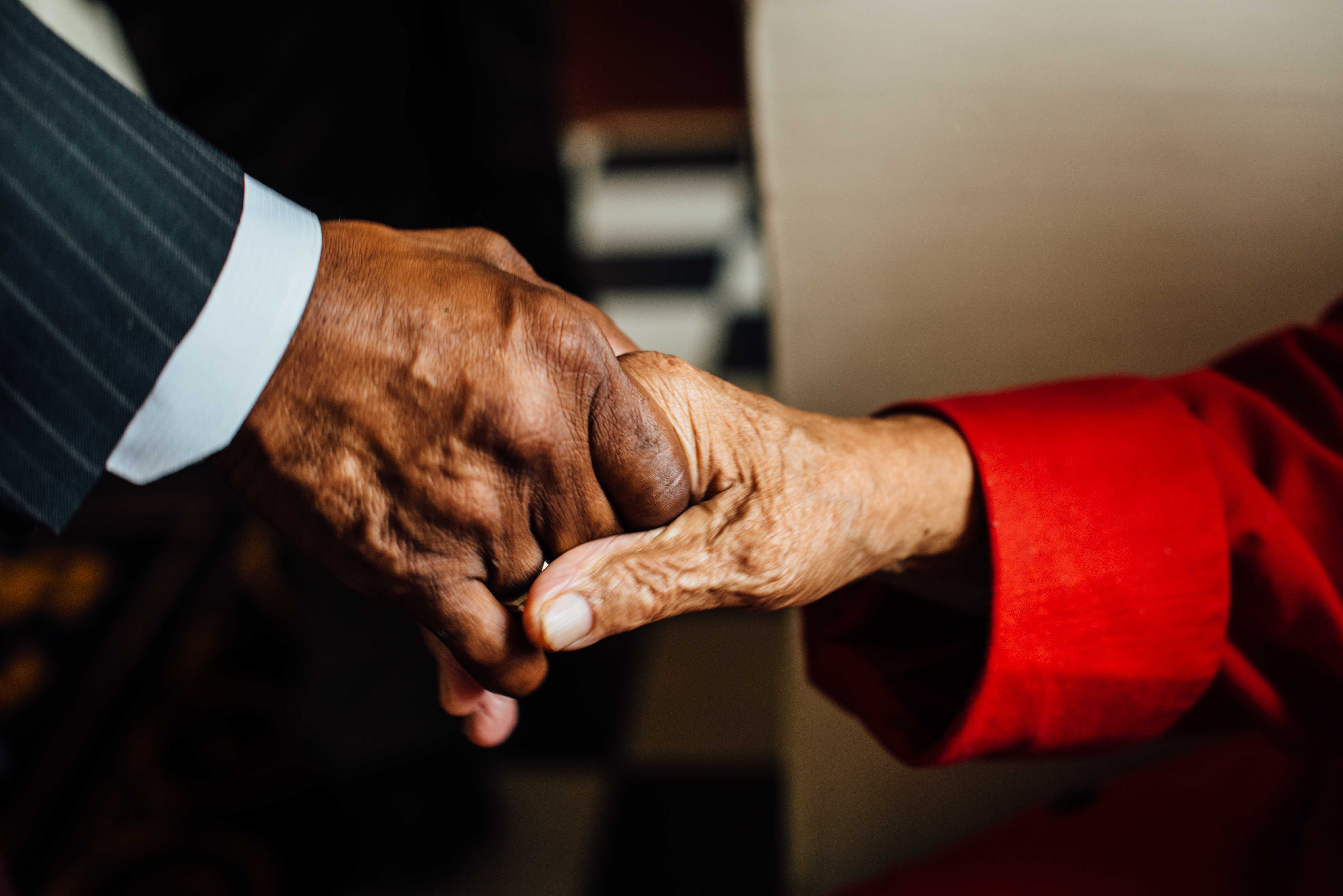
The night before he integrated the University of Mississippi, James Meredith stayed in the Chases’ home.
Serving people who were changing American society “gave me something to build on,” said Mrs. Chase, who counted Gen. George S. Patton and George Washington Carver among her heroes.
She was “a woman of tremendous courage who always stood up for what she believes is right,” said Susan Kantrow, a longtime friend.
During that period, Mrs. Chase started catering the openings of fledgling artists so they could offer hospitality to people who had come to admire – and, perhaps, buy – their creations. She helped them pay their bills, and she hung their works in the restaurant.
This love of art, born when she studied art in high school, led to service on the boards of the New Orleans Museum of Art and the Arts Council of New Orleans. Mrs. Chase also sat on the boards of the Louisiana Children’s Museum, the Urban League of Greater New Orleans and the Greater New Orleans Foundation.
“Leah got up every morning prepared to make a difference in people’s lives,” said Poppy Tooker, a cookbook author and self-styled culinary activist. “She was one of the most selfless people I’ve ever known because she never came at anything as what it could do for her. It was about how she could fix it, how she could change it.”
One way she sought to make a difference was through her membership in Women of the Storm, a group of about 140 women from all over the city who flew to Washington to lobby Congress for money to restore the city, the wetlands and the coastline. On the organization’s second trip, she was part of the delegation tapped to go to the White House; while there, she toured the kitchen, said Anne Milling, the group’s founder.
“Just her presence said a lot about the importance of our going to Washington,” Milling said. “She had the respect of all the women because she had been such a role model.”
Mrs. Chase made the first two trips while her restaurant was being restored. “For her to leave rebuilding the restaurant to go with us gave an imprimatur to the group,” Milling said. “It said that what we were doing was important.”
Mrs. Chase regularly provided food for nonprofit organizations’ fundraisers and refused to submit bills, said Morial, the widow of one New Orleans mayor and the mother of another.
“She provided food for the Amistad Research Center and would not take money. That was her contribution,” said Morial, an Amistad board member. “We’d tell her this was a fundraiser. She said, ‘I know, and you need all the money you can raise.’”
Mrs. Chase’s works were rewarded with honorary degrees from Tulane, Loyola, Dillard and Johnson & Wales universities; Our Lady of Holy Cross College; and Madonna College. Xavier University gave her the Francis Anthony Drexel Medal, its highest honor.
The Southern Food and Beverage Museum named a gallery for her, and she has received awards from the NAACP, the National Conference of Christians and Jews and the National Conference of Negro Women. Mrs. Chase, a founding member of the Southern Foodways Alliance and its first board president, received the organization’s first lifetime achievement award.
Oral History: Leah Chase | Dooky Chase Restaurant from Southern Foodways on Vimeo.
In 2009, the Louisiana Restaurant Association named her its Restaurateur of the Year.
Mrs. Chase felt more love from the food community when she was struggling to rebuild her restaurant after the building marinated in Katrina’s floodwaters that stood about 4 feet high.
On the first post-Katrina Holy Thursday, a gumbo z’herbes luncheon at Muriel’s Restaurant raised about $40,000 – about one-sixth of the damage estimate – and Southbend gave her a new stove to replace the one she had been using for decades.
Starbucks Coffee Co. and the NAACP donated $175,000, and her local fans and friends attended a series of fundraising dinners.
At each event to help her rebuild, Mrs. Chase fretted about giving back to repay a tribute that she didn’t feel she deserved.
“I’ll have to live 10 more years to pay you back,” she said to the cheering crowd at her 90th-birthday luncheon. “I can’t afford to die.”
She gave back by writing cookbooks – “The Dooky Chase Cookbook,” “And Still I Cook” and “Down Home Healthy: Family Recipes of Black American Chefs” – and by teaching, often at Folse’s classes at Nicholls State University.
“You can’t be closer to culinary genius than when Leah was in the classroom,” he said. “The moment she started to speak to them with that warm voice and the sparkle in her eyes, they wanted her to be a mentor.”
Folse praised her “loving, soft-spoken voice,” adding, “They were mesmerized by her.”
Even in the most contentious arguments, when people were fighting to be heard, “the only one who didn’t have to clamor was Mrs. Chase,” Edge said. “The words washed over you because the cadence and delivery were beautiful. It was a challenge to do more.”
He recalled an ugly Southern Foodways Alliance debate over whether fried chicken originated in Africa or Europe.
“It was a smart debate,” Edge said, “but Mrs. Chase stood up and said, ‘Why does this need to be black? Why does it need to be white? This food culture is ours together.’
“That was her message through the years: finding common ground. Her cooking did that, and she lived that.”
Her husband, Edgar “Dooky” Chase Jr., died in 2016.
Survivors include a son, Edgar Chase III of New Orleans; two daughters, Leah Chase Kamata and Stella Chase Reese, both of New Orleans; as well as siblings, grandchildren and great-grandchildren.
Funeral arrangements are incomplete.





